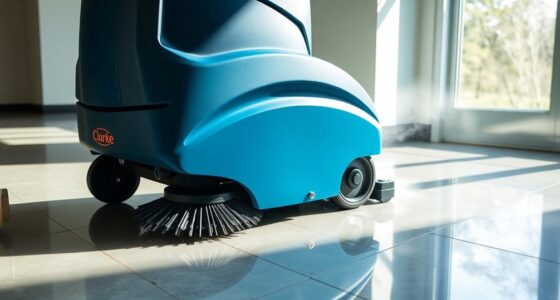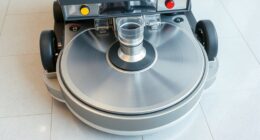Using the wrong pH in your cleaning solutions can damage your scrubber brushes quickly. Acidic cleaners (low pH) can cause metal corrosion and rubber breakdown, while alkaline solutions (high pH) may weaken plastic and brush bristles. Regularly checking and adjusting your solution’s pH, following manufacturer guidelines, and inspecting brushes for damage can prevent costly wear and tear. Continue exploring to discover more tips on protecting your equipment and maintaining best cleaning results.
Key Takeaways
- Using cleaning solutions with incorrect pH levels causes chemical corrosion and damages brush bristles.
- Neglecting regular pH testing allows solutions to become too acidic or alkaline, harming brushes over time.
- Applying highly acidic or alkaline solutions without manufacturer guidance weakens bristles and degrades brush materials.
- Reusing or mixing incompatible solutions can alter pH, increasing the risk of damage to scrubber brushes.
- Failing to replace or adjust solutions as they become unbalanced accelerates wear and shortens brush lifespan.

Many cleaning mistakes stem from misunderstanding the importance of pH levels in cleaning solutions, and one of the most common errors is using the wrong pH balance that damages your scrubber brushes. When you choose a cleaning solution with an inappropriate pH, you risk causing chemical corrosion to both the brushes and the underlying equipment. Acidic cleaners, with low pH levels, can eat away at metal parts and rubber components, leading to premature wear and tear. Conversely, highly alkaline solutions, with high pH values, can degrade plastic and rubber parts, making your brushes less effective and more prone to breakage. Recognizing that pH imbalance isn’t just about cleaning efficiency but also about preserving the integrity of your equipment is essential. Using solutions with improper pH levels is often a result of inadequate knowledge or neglecting proper maintenance protocols, which can quickly lead to costly repairs and replacements.
Chemical corrosion is often a silent threat that many overlook, especially when solutions are used without considering their pH compatibility with your scrubber brushes. If you regularly use harsh chemicals at the wrong pH, you might notice the bristles becoming brittle or discolored, and metal parts might develop rust or pitting. Over time, this damage compromises the effectiveness of your cleaning equipment and increases downtime because of frequent repairs. The root cause is usually improper maintenance—failing to regularly check and adjust cleaning solutions according to manufacturer recommendations or neglecting to replace solutions before they become too aggressive. Proper maintenance involves understanding which pH levels are safe for your specific brushes and ensuring that your cleaning products stay within those ranges. This proactive approach helps prevent chemical corrosion and extends the lifespan of your brushes. Additionally, understanding the effects of pH on materials can help in selecting the right cleaning agents to prevent damage.
To avoid these issues, always verify the pH level of your cleaning solutions and opt for products formulated specifically for your scrubber brushes. If you’re unsure, consult the manufacturer’s guidelines or seek advice from cleaning professionals. Regularly inspecting your brushes for signs of chemical damage—such as fraying, discoloration, or stiffness—can alert you to potential pH problems before they worsen. Implementing a routine maintenance schedule that includes testing and adjusting cleaning solutions ensures your equipment remains in ideal condition. Remember, proper maintenance isn’t just about replacing parts; it’s about understanding how chemical properties interact with your tools. By respecting the importance of pH balance, you can prevent chemical corrosion, extend your scrubber brushes’ lifespan, and keep your cleaning operations running smoothly and efficiently.
Frequently Asked Questions
Can Using Hot Water Damage Scrubber Brushes?
Using hot water can indeed cause brush damage over time. When you regularly expose scrubber brushes to hot water, the bristles may soften, warp, or weaken, reducing their effectiveness. To avoid this, stick to warm or cold water for cleaning your brushes. This gentle approach helps extend the lifespan of your scrubber brushes, ensuring they remain sturdy and efficient for longer periods.
How Often Should I Replace My Scrubber Brushes?
Like a wise old sage once said, “When the brush’s tale is told,” it’s time to replace it. You should consider your scrubber brush’s longevity and replacement frequency based on usage, signs of wear, and cleaning effectiveness. Typically, replace your brushes every 3 to 6 months for maximum performance. Regularly inspecting them ensures you catch wear early, preventing damage and maintaining cleanliness in your space.
Are There Eco-Friendly Cleaning Solutions for Scrubber Brushes?
You can definitely find eco-friendly cleaning solutions for your scrubber brushes. Look for biodegradable options that break down naturally without harming the environment. Non-toxic solutions are also a great choice, as they’re safe for you and the planet. Using these alternatives helps extend your brushes’ lifespan and reduces chemical waste. Always read labels to make sure you’re choosing sustainable, eco-conscious products that support a greener, healthier cleaning routine.
Does Brush Material Affect Ph Compatibility?
Think of your scrubber brush as a delicate dancer on the stage of cleaning. The material you choose acts as their partner, influencing pH sensitivity and brush durability. If the material is pH sensitive, harsh cleaners can cause damage, shortening its lifespan. Selecting the right material guarantees your brush remains resilient and effective, allowing your cleaning routine to shine without risking damage from incompatible pH levels.
Can Improper Storage Cause Brush Deterioration?
Improper storage can definitely cause your scrubber brushes to deteriorate. Poor storage conditions, like exposure to moisture, extreme temperatures, or direct sunlight, can weaken the brush material over time. Additionally, if storage isn’t designed with chemical compatibility in mind, harmful reactions may occur, accelerating deterioration. To prevent this, store brushes in a cool, dry place away from chemicals, ensuring they stay in good condition and last longer.
Conclusion
Just like a chef who ruins a perfect sauce by adding too much salt, a small pH mistake can ruin your scrubber brushes. I once saw a plant’s entire cleaning system fail because of overlooked pH levels—costing time and money. Remember, maintaining proper pH isn’t just a detail; it’s the secret ingredient to extending your scrubbers’ life. Pay attention, stay precise, and your brushes will serve you well for years to come.









